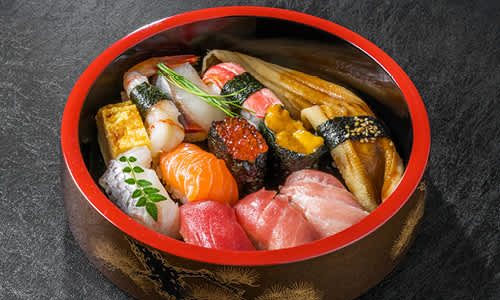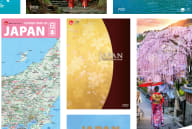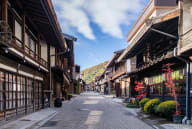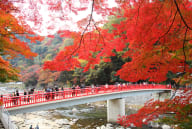
Tokyo From street food to gourmet delights.
A Culinary Journey in Tokyo
Tokyo, Japan's bustling capital, is a dynamic metropolis where tradition and innovation coexist harmoniously. With its distinctive geography, Tokyo is surrounded by mountains to the west and the Pacific Ocean to the east, contributing to a varied climate that supports a wide range of agricultural products. Despite its urban sprawl, Tokyo's dedication to fresh, locally-sourced ingredients is evident in its celebrated food culture.
The city's rich culinary landscape features famous produce like Edomae vegetables, cultivated in the fertile outskirts, and fresh seafood from the nearby Tsukiji and Toyosu markets. Tokyo's gastronomy is a delightful blend of high-end dining and comforting street food, offering everything from world-renowned sushi to hearty bowls of ramen.
Tokyo’s culinary offerings are as diverse as the city itself. Savour the exquisite Edomae sushi, prepared with the freshest fish from Tokyo Bay, or indulge in tempura, with vegetables and seafood fried to perfection. Try Monja-yaki, a savoury fried batter dish, filled with an assortment of ingredients, a local favourite in the Tsukishima area. Tokyo also boasts an incredible variety of foods from across Japan and around the world.
Embark on a unique gastronomic journey through culturally diverse Tokyo, where meticulous preparation, seasonal ingredients, and a seamless fusion of old and new await your palate.
Edomae sushi (Edo style sushi)

What it is (ingredients)
Edomae sushi, originated in the late Edo period, around 1800, in Tokyo (formerly Edo). "Edomae" refers to the area in front of Edo Castle (now known as the Imperial Palace), as well as to the fish caught in the waters around Tokyo Bay. Edomae sushi distinguishes itself through various techniques like salting, vinegar pickling, steaming, boiling, or marinating fresh seafood from Tokyo Bay to intensify flavours and ensure preservation, paired with vinegared rice. Additionally, a hallmark of Edomae sushi is the application of soy sauce and mirin-based sauce using a brush before serving.
History/Origin
Edomae sushi emerged as a convenient street food in bustling Edo. It was pioneered by a sushi chef in Tokyo, who ingeniously paired fish from Edo Bay with vinegared rice, creating a delectable, portable meal for busy Edo people. Over time, Edomae sushi has evolved into a refined culinary art, maintaining its focus on quality ingredients and precise cooking methods.
Where You Can Eat
Edomae sushi can be enjoyed at sushi restaurants throughout Tokyo and beyond. From high-end sushi bars to more casual establishments, the tradition of Edomae sushi is upheld with a focus on quality and presentation. You can find it at local markets, sushi chains, and fine dining restaurants, each offering its own take on this historic style of sushi.
When to Eat
Edomae sushi offers a year-round delight. Its versatility and diverse flavours cater to both everyday dining and special occasions. With ingredients sourced for freshness, each season brings its unique touch to the experience.
Experience the exquisite taste of Edomae sushi and indulge in a piece of Tokyo's rich culinary heritage!
Chanko-nabe (Sumo wrestler’s hot pot)

What it is
Chanko-nabe is a wholesome hot pot dish traditionally consumed by sumo wrestlers. The ingredients vary, but a typical Chanko-nabe includes chicken, fish, tofu, and a variety of vegetables such as napa cabbage, shiitake mushrooms, and daikon radish, all simmered in a rich dashi or chicken broth. The dish is often seasoned with soy sauce or miso, and udon or rice can be added for extra sustenance.
History/Origin
Chanko-nabe originated in sumo stables to provide wrestlers with a nutritious and high-calorie meal to help them gain weight and increase their strength. "Chanko" refers to any meal prepared by sumo wrestlers, not just hot pot dishes. The name is believed to come from the terms "To-chan" (father) and "Ka-chan" (mother), affectionately referring to the stable master and his wife, who act as substitute parents to the wrestlers. "Ko" means child, reflecting the communal and familial nature of sumo life. Each stable developed its own recipes, resulting in a wide variety of flavours and styles.
Where You Can Eat
While originally confined to sumo stables, Chanko-nabe can now be enjoyed at specialty restaurants throughout Tokyo. Especially around Ryogoku Kokugikan, the venue for sumo matches, there are many Chanko-nabe restaurants run by retired sumo wrestlers.
When to Eat
Chanko-nabe is typically enjoyed during the colder months, as its warm and nourishing qualities make it perfect for winter. However, it's also a popular choice year-round for those seeking a robust and filling meal.
Sit around Chanko-nabe with your loved ones and savour the flavours that fuel Japan's iconic sumo wrestlers.
Monja-yaki (Pan-fried batter)

What it is (ingredients)
Monja-yaki is a deliciously savoury pan-fried batter dish that includes a variety of ingredients. The base is a thin batter made from flour and water, mixed with finely chopped cabbage, tempura scraps, and small pieces of seafood like squid or shrimp. Toppings such as cheese, corn, Mentaiko (spicy cod roe), and mochi can also be added for extra flavour.
History/Origin
The roots of Monja-yaki, which originated in Tokyo, date back to the late Edo period (1800s). Initially a children's snack with simple ingredients, it has since evolved into a popular street food and restaurant favourite. It especially developed in the Tsukishima area of Tokyo, which is still known as the capital of Monja-yaki. This dish reflects the resourcefulness of Tokyoites who transform simple ingredients into beloved culinary traditions.
Where You Can Eat
Monja-yaki is best experienced on the so-called “Monja street” of Tsukishima, Tokyo, where numerous specialty restaurants serve this unique dish. It's also available at various Izakaya (Japanese style dining bars) and street food stalls throughout the city, offering a taste of Tokyo's vibrant food culture.
When to Eat
Monja-yaki can be enjoyed year-round, making it a versatile choice for any season. Its interactive cooking style, where diners cook the dish themselves on a hot griddle, makes it a fun and engaging dining experience for gatherings with friends and family.
Dive into the rich, interactive world of Monja-yaki and enjoy a taste of Tokyo's culinary creativity.































































